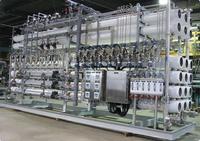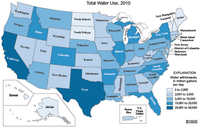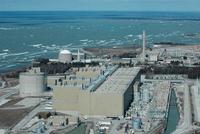-
Project cuts phosphorus levels in river
A 7-year pilot project in the 12,000-acre Pleasant Valley subwatershed of the Pecatonica River in southwestern Wisconsin has helped to reduce the amount of phosphorus and sediment entering the river after major storms by more than a third. The project involved changing practices on just ten of the valley’s sixty-one farms. Certain practices, such as reducing tillage and planting crops that leave more residue to protect the soil, caused the estimated annual amounts of phosphorus and sediment entering the river to drop by 4,400 pounds and 1,300 tons, respectively.
-
-
L.A. water supply vulnerable to disruption by earthquakes
Eighty-eight percent of Los Angeles’s water comes from the Colorado River, Owens Valley, and the Sacramento-San Joaquin River Delta, passing through three major aqueducts and into the region. The aqueducts cross the San Andreas Fault a total of thirty-two times, making them vulnerable to the much anticipated Big One.A large temblor on the fault could destroy sections of the aqueducts, cutting off the water supply for more than twenty-two million people in Southern California.
-
-
It will take 11 trillion gallons to replenish California drought losses: NASA
Since 2011, the Sacramento and San Joaquin river basins decreased in volume by four trillion gallons of water each year (fifteen cubic kilometers). This is more water than California’s thirty-eight million residents use each year for domestic and municipal purposes. About two-thirds of the loss is due to depletion of groundwater beneath California’s Central Valley. It will take about eleven trillion gallons of water (forty-two cubic kilometers) — around 1.5 times the maximum volume of the largest U.S. reservoir — to recover from California’s continuing drought, according to a new analysis of NASA satellite data.
-
-
Water’s role in the rise and fall of the Roman Empire
The Roman Empire, stretching over three continents and persisting for many centuries, was home to an estimated seventy million people. In such a vast area ensuring a stable food supply was no easy task, particularly given the variable and arid climate of the Mediterranean region. Smart agricultural practices and an extensive grain-trade network enabled the Romans to thrive in the water-limited environment of the Mediterranean, a new study shows. The stable food supply brought about by these measures, however, promoted population growth and urbanization, pushing the Empire closer to the limits of its food resources.
-
-
Nimble robot expedites, simplifies water pipe inspections
Between 30 and 50 percent of Europe’s drinking water are being lost every year due to pipe leakages. Norwegian researchers have developed an inspection methodology for water distribution grids. A long, torpedo-like and propeller-driven robot is guided through the water and district heating pipe systems. It is equipped with sixty-four large ultrasound transducers which transmit and receive ultrasound signals. It collects data which enable us calculate the thickness of, and levels of corrosion in, the pipes.
-
-
Debate over California’s Salton Sea rescue plan coming to a head
The California State Water Resources Control Board (SWRCB) is currently reviewing a plan to arrest the deterioration of the Salton Sea, a shallow, saline lake which runs along the state’s Imperial and Coachella valleys above the San Andreas Fault. The Salton Sea was inadvertently created by engineers with the California Development Company when they cut off a series of canals in an effort to manage river flooding between 1904 to 1906. It has since been a popular vacation destination.
-
-
A solution to the U.S. water problem: People who use more water, pay more
Approximately one-third of the United States is in at least a moderate state of drought. Exacerbating the drought is a rapidly increasing population. The U.S. Census Bureau estimates the country’s population will balloon from nearly 310 million in 2010 to more than 420 million in 2060. Experts say that current levels of water consumption cannot continue. One expert says that seasonally adjusted increasing block rates could be the answer. In short, people who use more water, pay more.
-
-
New online sensor improves quality check of drinking water
A Dutch doctoral candidate has developed an online sensor which can be used to check the quality of the water in a water purification plant more accurately and more cheaply. Amongst other things, the sensor can measure the amount of rust, salts, bacteria, or alcohol a liquid contains. With this sensor the water purification companies and other companies can save a lot of money, as they can better assess when they have to replace or clean the installations and pipes.
-
-
San Francisco to add local groundwater to reservoir supply
The San Francisco Public Utilities Commission has begun digging in the area around Golden Gate Park with the intention of adding local underground water flows to the traditionally sourced water from the Hetch Hetchy Reservoir in Yosemite. The change is expected to take place over the next two years and will replace between 10 to 15 percent of the water supply. Despite the fact that the water is less pure, city officials expect that difference will be negligible.
-
-
Selling and buying water rights
Trying to sell or buy water rights can be a complicated exercise. First, it takes time and effort for buyers and sellers to find each other, a process that often relies on word-of-mouth, local bulletin boards, even calling friends and neighbors to get the word out. Then they must deal with the maze of rules and regulations involved. Finally, they must reach a fair price. It would be much easier if a computer could do it. Now, one can. Scientists have developed an algorithm that can match potential buyers and sellers, sift through the complexity of local physical and regulatory systems, and reach a fair deal designed especially for them.
-
-
Water sector ready for investment, technological innovation

Investors looking for promising growth markets would do well to consider their water bill. Water’s artificially low price in most of the United States is one factor holding back innovative new water technologies, according to the report – but the time is right for change. Across the West, drought has left wide swaths of agricultural land brown, with massive wildfires raging through tinder-dry forests, residential wells tapped out and unemployed farm workers crowding food pantries. The drought is projected to cost the agricultural sector about $2.2 billion in 2014. The social and ecological damage is also profound. Technological innovation in the water sector could bring a raft of benefits ranging from the conservation of scarce water supplies to the expansion of water supplies through technologies that recycle or desalinate, for example.
-
-
U.S. water-use at lowest levels since before 1970

Water use across the United States reached its lowest recorded level in nearly forty-five years. According to a new USGS report, about 355 billion gallons of water per day (Bgal/d) were withdrawn for use in the entire United States during 2010. This represents a 13 percent reduction of water use from 2005 when about 410 Bgal/d were withdrawn and the lowest level since before 1970.
-
-
As drought continues, more Californians turn to greywater
California’s rainy season tends to run from October to late March, but for the third year in a row rain has been relatively absent, meaning that the state is currently suffering from a severe, unprecedented drought. With increasing water rates, a growing number of homeowners in Southern California are relying on greywater systems to support their landscapes and toilet flushing. “If the drought continues, honestly, I could see all new construction will have greywater systems of some kind because it really doesn’t make sense to put usable water in the sewer system,” says one expert.
-
-
Groundwater could be polluted with heavy metals by fracking flowback
The chemical makeup of wastewater generated by “hydrofracking” could cause the release of tiny particles in soils that often strongly bind heavy metals and pollutants, exacerbating the environmental risks during accidental spills, Cornell University researchers have found. Previous research has shown 10 to 40 percent of the water and chemical solution mixture injected at high pressure into deep rock strata, surges back to the surface during well development. Researchers found that the same properties that make the mixture so effective at extracting natural gas from shale can also displace tiny particles that are naturally bound to soil, causing associated pollutants such as heavy metals to leach out.
-
-
Debate over Ontario, Canada underground nuclear waste facility intensifies

Ontario Power Generation’s (OPG) proposal to construct an underground nuclear waste disposal facility near the company’s Bruce Nuclear plantand on the edge of the Great Lakes is facing growing opposition from local municipalities and environmentalists. The facility would store low and intermediate nuclear waste from OPG’s Bruce, Pickering, and Darlington nuclear facilities. Environmentalists are concerned that a leak in the underground facility would be devastating for communities which depend on water from the Great Lakes.
-
- All
- Regional
- Water
- Biometrics
- Borders/Immig
- Business
- Cybersecurity
- Detection
- Disasters
- Government
- Infrastructure
- International
- Public health
- Public Safety
- Communication interoperabillity
- Emergency services
- Emergency medical services
- Fire
- First response
- IEDs
- Law Enforcement
- Law Enforcement Technology
- Military technology
- Nonlethal weapons
- Nuclear weapons
- Personal protection equipment
- Police
- Notification /alert systems
- Situational awareness
- Weapons systems
- Sci-Tech
- Sector Reports
- Surveillance
- Transportation
Advertising & Marketing: advertise@newswirepubs.com
Editorial: editor@newswirepubs.com
General: info@newswirepubs.com
2010-2011 © News Wire Publications, LLC News Wire Publications, LLC
220 Old Country Road | Suite 200 | Mineola | New York | 11501
Permissions and Policies
Editorial: editor@newswirepubs.com
General: info@newswirepubs.com
2010-2011 © News Wire Publications, LLC News Wire Publications, LLC
220 Old Country Road | Suite 200 | Mineola | New York | 11501
Permissions and Policies
